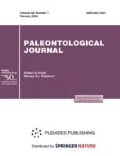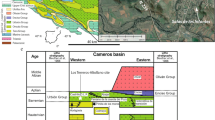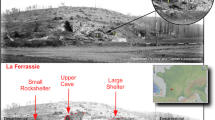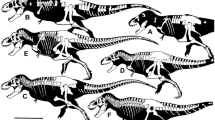Abstarct
The paper discusses a group of the Late Vendian fossils supposedly related to mollusks. The fossils include imprints with some anatomical characteristics of mollusks, traces resembling scratch marks left by radula, and structures resembling soft shells. Kimberella quadrata, which is represented by all the above kinds of fossils was most likely a trochophore animal of a pre-molluscan evolutionary stage. Remains of Armillifera parva and Solza margarita only slightly resemble shells, and in the absence of the knowledge on the soft body of these animals there are no enongh evidences affiliate them with mollusks.
Similar content being viewed by others
References
J. Dzik and A. Yu. Ivantsov, “Internal Anatomy of a New Precambrian Dickinsoniid Dipleurozoan from Northern Russia,” N. Jb. Geol. Paläont. Mh., No. 7, 385–396 (2002).
M. A. Fedonkin, “Systematic Description of the Vendian Metazoa,” in The Vendian System, Vol. 1, Paleontology, Ed. by B. S. Sokolov and A. B. Ivanovski (Springer-Verlag, New York, 1990), pp. 71–120.
M. A. Fedonkin and B. M. Waggoner, “The Late Precambrian Fossil Kimberella Is a Mollusc-Like Bilaterian Organism,” Nature 388(6645), 868–871 (1997).
M. A. Fedonkin, “Glimpse into 600 Million Years Ago,” Science in Russia 6(126), 4–15 (2001).
M. A. Fedonkin, “The Origin of the Metazoa in the Light of the Proterozoic Fossil Record,” Paleontol. Res. 7(1), 9–41 (2003).
M. A. Fedonkin and P. Vickers-Rich, “First Trace of Motion,” in The Rise and Fall of the Ediacaran Biota (Geol. Soc. London Spec. Publ. Vol. 286), Ed. by P. Vickers-Rich and P. Komarower (Geol. Soc. Publ. House, London, 2007), pp. 205–216.
M. A. Fedonkin, A. Simonetta, and A. Yu. Ivantsov, “New Data on Kimberella, the Vendian Mollusc-Like Organism (White Sea Region, Russia): Palaeoecological and Evolutionary Implications,” in The Rise and Fall of the Ediacaran Biota (Geol. Soc. London Spec. Publ. Vol. 286), Ed. by P. Vickers-Rich and P. Komarower (Geol. Soc. Publ. House, London, 2007), pp. 157–179.
J. G. Gehling, “The Case of Ediacaran Fossil Roots to the Metazoan Tree,” Mem. Geol. Soc. India, No. 20, 181–224 (1991).
J. G. Gehling, “Ediacara Organisms: Relating Form to Function,” in Evolving Form and Function: Fossils and Development: Proc. Sympos. Honoring Adolf Seilacher, Ed. by D. E. G. Briggs (Yale Univ. Press, New Haven, 2005), pp. 43–66.
M. F. Glaessner and B. Daily, “The Geology and Late Precambrian Fauna of the Ediacara Fossil Reserve,” Rec. South Austral. Mus. 13(3), 369–401 (1959).
M. F. Glaessner and M. Wade, “The Late Precambrian Fossils from Ediacara, South Australia,” Palaeontology 9(4), 599–628 (1966).
D. Grazhdankin, “Structure and Depositional Environment of the Vendian Complex in the Southeastern White Sea Area,” Stratigr. Geol. Korrelyatsiya 11(4), 3–23 (2003) [Stratigr. Geol. Correlation 11 (4), 313–331 (2003)].
A. Yu. Ivantsov and M. A. Fedonkin, “Traces of Spontaneous Movement: Final Proof of the Animal Nature of Ediacaran Organisms,” in Proceedings of the 2nd International Symposium on the Evolution of Life on the Earth, Tomsk, November 12–15, 2001, Ed. by V. M. Podobina (Izd. Nauchno-Tekh. Lit-ry, Tomsk, 2001a), pp. 133–137 [in Russian].
A. Yu. Ivantsov and M. A. Fedonkin, “Locomotion Trails of the Vendian Invertebrates Preserved with the Producer’s Body Fossils, White Sea, Russia,” in Abstracts of North American Paleontological Convention (PaleoBios, Berkeley, 2001b), Vol. 21, p. 72.
A. Yu. Ivantsov and Ya. E. Malakhovskaya, “Giant Traces of Vendian Animals,” Dokl. Ross. Akad. Nauk 385A(3), 382–386 (2002) [Dokl. Earth Sci. 385A (6), 618–622 (2002)].
A. Yu. Ivantsov, “New Proarticulata from the Vendian of the Arkhangel’sk Region,” Paleonol. Zh., No. 3, 21–26 (2004) [Paleonol. J. 38 (3), 247–253 (2004)].
A. Yu. Ivantsov, Ya. E. Malakhovskaya, and E. A. Serezhnikova, “Some Problematic Fossils from the Vendian of the Southeastern White Sea Region,” Paleontol. Zh., No. 1, 3–9 (2004) [Paleontol. J. 38 (1), 1–9 (2004)].
A. Yu. Ivantsov, “Proarticulata—a Phylum of Multicellular Animals that Became Extinct in the Precambrian,” in Evolutionary Morphology of Animals. Conference in Memory of the 100th Anniversary of Academician A.V. Ivanov. Part 1: Proceedings of the St. Petersburg Society of Naturalists (S.-Peterb. Gos. Univ. Press, St. Petersburg, 2008), Ser. 1, Vol. 97, pp. 32–42 [in Russian].
A. Yu. Ivantsov, “A New Reconstruction of Kimberella—a Problematic Vendian Metazoan,” Paleontol. Zh., No. 6, 3–12 (2009) [Paleontol. J. 43 (6), 601–611 (2009)].
R. J. F. Jenkins, “Functional and Ecological Aspects of Ediacaran Assemblages,” in Origin and Early Evolution of the Metazoa, Ed. by J. Lipps and P. Signor (Plenum Press, New York, 1992), pp. 131–176.
R. J. F. Jenkins, “The Problems and Potential of Using Animal Fossils and Trace Fossils in Terminal Proterozoic Biostratigraphy,” Precambrian Res. 73(1–4), 51–69 (1995).
C. Nielsen, Animal Evolution. Interrelationships of the Living Phyla (Oxford Univ. Press, Oxford, 2001).
P. Yu. Parkhaev, “Chapter 3: The Early Cambrian Radiation of Mollusca,” in Phylogeny and Evolution of Molluscs, Ed. by W. F. Ponder and D. R. Lindberg (Univ. California Press, Berkeley, 2008), pp. 33–69.
E. Ruppert, R. S. Fox, and R. D. Barnes, Invertebrate Zoology: A Functional Evolutionary Approach, 7th ed. (Thomas-Brooks/Cole, Belmont, CA, USA, 2004).
A. Seilacher, “Biomat-Related Lifestyles in the Precambrian,” Palaios 14(1), 86–93 (1999).
A. Seilacher, D. Grazhdankin, and A. Leguta, “Ediacaran Biota: The Dawn of Animal Life in the Shadow of Giant Protists,” Paleontol. Res. 7(1), 43–54 (2003).
A. Seilacher, Trace Fossil Analysis (Springer-Verlag, Berlin-Heidelberg-New York, 2007).
P. Trusler, J. Stilwell, and P. Vickers-Rich, “Comment: Future Research Directions for Further Analysis of Kimberella,” in The Rise and Fall of the Ediacaran Biota (Geol. Soc. London Spec. Publ. Vol. 286), Ed. by P. Vickers-Rich and P. Komarower (Geol. Soc. Publ. House, London, 2007), pp. 181–185.
M. Wade, “Hydrozoa and Scyphozoa and Other Medusoids from the Precambrian Ediacara Fauna, South Australia,” Palaeontology 15(2), 197–225 (1972).
Author information
Authors and Affiliations
Rights and permissions
About this article
Cite this article
Ivantsov, A.Y. Paleontological evidence for the supposed precambrian occurrence of mollusks. Paleontol. J. 44, 1552–1559 (2010). https://doi.org/10.1134/S0031030110120105
Received:
Published:
Issue Date:
DOI: https://doi.org/10.1134/S0031030110120105




